Biological macromolecules - Study guides, Class notes & Summaries
Looking for the best study guides, study notes and summaries about Biological macromolecules? On this page you'll find 1619 study documents about Biological macromolecules.
Page 3 out of 1.619 results
Sort by

-
BIOD 171 Portage Learning Final EXAM Questions and Answers 100%Correct/Exam 1-7 2023/2024 Update
- Exam (elaborations) • 44 pages • 2023
-
- $20.99
- 5x sold
- + learn more
BIOD 171 Portage Learning Final EXAM Questions and Answers 100%Correct/Exam 1-7 2023/2024 UpdatePortage Learning BIOD 171 Final EXAM Questions and Answers 100%Correct/Exam 1-7 2023/2024 Update True or False: A virus is considered a microorganism. False. Viruses are not living and as such are not considered microorganisms. Viruses can, however, be classified as microbes, a more general term that includes microorganisms and viruses. 1. What is the smallest biological unit of life? A cell. ...
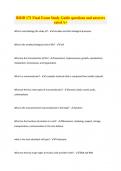
-
BIOD 171 Final Exam Study Guide questions and answers rated A+
- Exam (elaborations) • 23 pages • 2024
- Available in package deal
-
- $10.48
- + learn more
BIOD 171 Final Exam Study Guide questions and answers rated A+ What is microbiology the study of? - microbes and their biological processes What is the smallest biological unit of life? - cell What are the characteristics of life? - movement, responsiveness, growth, reproduction, metabolism, homeostasis, and organization What is a macromolecule? - a complex molecule that is composed from smaller subunits What are the four main types of macromolecules? - protein, lipids, nucleic acids, ca...
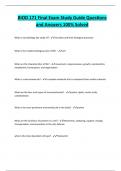
-
BIOD 171 Final Exam Study Guide Questions and Answers 100% Solved
- Exam (elaborations) • 21 pages • 2024
- Available in package deal
-
- $12.99
- + learn more
BIOD 171 Final Exam Study Guide Questions and Answers 100% Solved What is microbiology the study of? - microbes and their biological processes What is the smallest biological unit of life? - cell What are the characteristics of life? - movement, responsiveness, growth, reproduction, metabolism, homeostasis, and organization What is a macromolecule? - a complex molecule that is composed from smaller subunits What are the four main types of macromolecules? - protein, lipids, nucleic a...
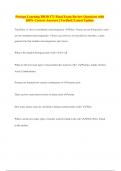
-
Portage Learning BIOD 171 Final Exam Review Questions with 100% Correct Answers | Verified | Latest Update
- Exam (elaborations) • 26 pages • 2024
- Available in package deal
-
- $11.98
- + learn more
Portage Learning BIOD 171 Final Exam Review Questions with 100% Correct Answers | Verified | Latest Update True/False. A virus is considered a microorganism. False, Viruses are not living and as such are not considered microorganisms. Viruses can, however, be classified as microbes, a more general term that includes microorganisms and viruses. What is the smallest biological unit of life? A cell What are the four main types of macromolecules found in cells? Proteins, Lipids, Nucleic Acids...
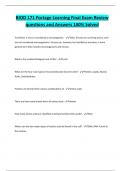
-
BIOD 171 Portage Learning Final Exam Review questions and Answers 100% Solved
- Exam (elaborations) • 25 pages • 2024
- Available in package deal
-
- $15.99
- + learn more
BIOD 171 Portage Learning Final Exam Review questions and Answers 100% Solved True/False. A virus is considered a microorganism. - False, Viruses are not living and as such are not considered microorganisms. Viruses can, however, be classified as microbes, a more general term that includes microorganisms and viruses. What is the smallest biological unit of life? - A cell What are the four main types of macromolecules found in cells? - Proteins, Lipids, Nucleic Acids, Carbohydrates ...
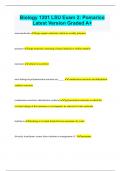
-
Biology 1201 LSU Exam 2: Pomarico Latest Version Graded A+
- Exam (elaborations) • 20 pages • 2024
- Available in package deal
-
- $9.99
- + learn more
Biology 1201 LSU Exam 2: Pomarico Latest Version Graded A+ macromolecules large organic molecules which are usually polymers polymers large molecules consisting of many identical or similar subunits monomer subunit of a polymer most biological polymerization reactions are_____ condensation reactions aka dehydration synthesis reactions condensation reactions (dehydration synthesis) polymerization reactions in which the covalent linkage of the monomers is accompanies by removal...

-
AP Bio FRQs Exam; Questions & Answers 100% Solved
- Exam (elaborations) • 20 pages • 2024
- Available in package deal
-
- $13.99
- + learn more
AP Bio FRQs Exam; Questions & Answers 100% Solved Describe the role of carbon in biological systems. Correct answer-The response indicates that carbon is used to build biological macromolecules such as carbohydrates, proteins, nucleic acids, and lipids. Explain how, when the membranes are fused, the polar parts of the phospholipids from one cell will interact with the phospholipids from the other cell and how the nonpolar parts of the phospholipids from one cell will interact with the...

-
TEST BANK PATHOPHYSIOLOGY THE BIOLOGICAL BASIS FOR DISEASE IN ADULTS AND CHILDREN BY McCance
- Exam (elaborations) • 493 pages • 2023
- Available in package deal
-
- $6.69
- 4x sold
- + learn more
TEST BANK PATHOPHYSIOLOGY THE BIOLOGICAL BASIS FOR DISEASE IN ADULTS AND CHILDREN BY McCance Chapter 1: Cellular Biology MULTIPLE CHOICE 1. Which statement best describes the cellular function of metabolic absorption? a. Cells can produce proteins. c. Cells can take in and use nutrients. b. Cells can secrete digestive enzymes. d. Cells can synthesize fats. ANS: C In metabolic absorption, all cells take in and use nutrients and other substances from their surroundings. The remaini...
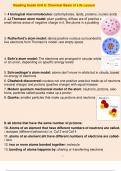
-
Reading Guide Unit 6: Chemical Basis of Life Lesson 1. 4 biological macromolecules: carbohydrates, lipids, proteins, nucleic acids 2. JJ Thomson atom model: plum pudding, diffuse are of positive charge with small dense areas of negative charge in it, like
- Exam (elaborations) • 2 pages • 2023
-
- $10.49
- + learn more
Reading Guide Unit 6: Chemical Basis of Life Lesson 1. 4 biological macromolecules: carbohydrates, lipids, proteins, nucleic acids 2. JJ Thomson atom model: plum pudding, diffuse are of positive charge with small dense areas of negative charge in it, like plums in a pudd
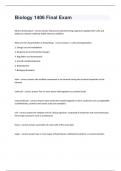
-
biol 1406 Collin College -Biology 1406 Final Exam
- Exam (elaborations) • 69 pages • 2024
- Available in package deal
-
- $19.99
- + learn more
biol 1406 Collin College -Biology 1406 Final Exam What is homeostasis - correct answer the process whereby living organisms regulate their cells and bodies to maintain relatively stable internal conditions What are the characteristics of living things - correct answer 1. Cells and Organization 2. Energy use and metabolism 3. Response to environmental changes 4. Regulation and homeostasis 5. Growth and Development 6. Reproduction 7. Biological Evolution atom - correct answer the smal...

Do you wonder why so many students wear nice clothes, have money to spare and enjoy tons of free time? Well, they sell on Stuvia! Imagine your study notes being downloaded a dozen times for $15 each. Every. Single. Day. Discover all about earning on Stuvia


